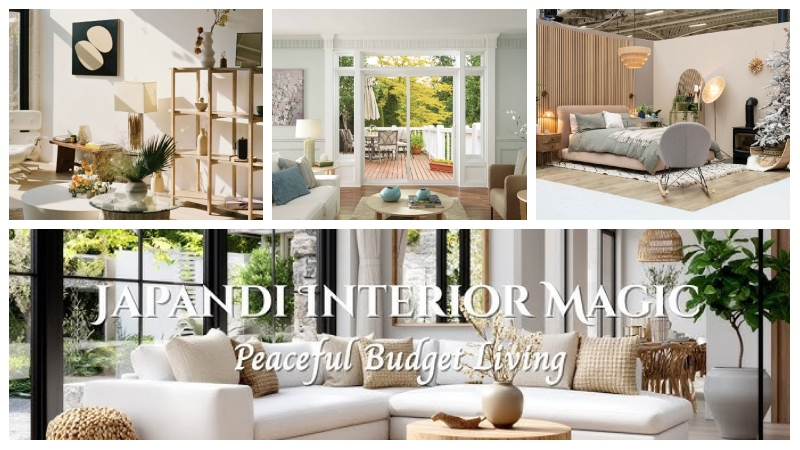Japandi design has quickly become one of the most loved interior styles in recent years. A beautiful fusion of Japanese minimalism and Scandinavian coziness, Jalandi is about creating a home that feels calm, balanced, and purposeful. If you’ve ever dreamed of a space that combines natural beauty with warm comfort, Jalandi might be the style for you.
What Is Japandi Design?
Japandi is a hybrid of Japanese “wabi-sabi” (finding beauty in imperfection and simplicity) and Scandinavian “hygge” (a sense of coziness and comfort). Together, these philosophies create interiors that are minimalist yet warm, functional yet inviting.
Rather than filling a home with trends, Jalanda emphasizes timeless pieces, natural textures, and thoughtful details. It’s about curating a sanctuary where everything has a purpose.
Key Elements of Jalandi Interiors
1. Minimalism with Warmth
Unlike stark minimalism, Jalandi isn’t about empty spaces. Instead, it uses clean lines and uncluttered layouts but balances them with warm textures—soft fabrics, handcrafted ceramics, or light wood finishes.
- Natural Materials
Wood, bamboo, stone, linen, and cotton are staples in Jalandi interiors. These materials bring nature indoors and age beautifully over time.
- Neutral and Earthy Colors
The Jalanda palette often includes warm beiges, taupe, soft whites, charcoal grays, and muted greens. Darker wood tones like walnut or espresso are used sparingly to add depth.
- Layered Lighting
A detail often overlooked, lighting is essential in Japandi interiors. Soft, diffused lighting such as paper lanterns, pendant lamps, or floor lamps with natural shades creates a calm, Zen-like glow.
- Functional Design
Furniture is practical but elegant, often low to the ground (inspired by Japanese interiors). Scandinavian influence adds comfort through cozy textiles and ergonomic shapes.
- Sustainability
Japandi favors eco-friendly and durable craftsmanship over disposable decor. Many Japandi enthusiasts invest in fewer, higher-quality pieces that last decades.
A Short History of Japandi
Though the name “Japandi” is modern, the design exchange between Japan and Scandinavia began in the late 19th century, when Nordic designers visited Japan after the country opened its borders. Both cultures valued simplicity, craftsmanship, and harmony with nature, leading to a natural design partnership that still resonates today.
How Japanese and Scandinavian Styles Complement Each Other
- Japanese interiors: sleek, refined, and rooted in Zen philosophy.
- Scandinavian interiors: rustic, cozy, and centered on comfort.
Together, they balance each other out. The softness of Scandi prevents Japanese design from feeling too austere, while Japanese refinement prevents Scandi spaces from feeling too casual.
How to Decorate Your Home in Japandi Style
- Start with a Calm Base
Choose a neutral wall color: soft beige, warm white, or light gray. Use one dominant shade and one accent color for a harmonious palette.
- Bring in Natural Materials
Opt for unfinished wood furniture, bamboo accents, linen cushions, and stoneware vases. Even small touches like woven baskets can bring Japandi warmth.
- Play with Texture
Layer soft rugs, wool throws, and tactile fabrics like boucle or linen to avoid flatness. Mix in ceramics, paper lamps, and raw wood for balance.
- Declutter with Purpose
Japandi is about simplicity. Hide excess items in woven storage boxes, low wooden cabinets, or built-in shelving. Think of “faux minimalism”—a clean look with hidden functionality.
- Incorporate Greenery
Plants such as bonsai, bamboo, or simple leafy greens add freshness and align with Japandi’s love for nature. Stick to fewer but larger plants for impact.
- Choose Quality Over Quantity
Instead of filling a room, invest in a few handcrafted, sustainable, and timeless pieces. Japandi is about longevity, not trends.
Bonus Tips (Not Always Mentioned)
- Lighting is everything: Use warm bulbs instead of harsh white lights.
- Tech integration: If you use smart home devices, hide them in wooden or neutral casings to maintain the aesthetic.
- DIY-friendly touches: Create your own Japandi look with hand-thrown pottery, DIY floating shelves, or repurposed wooden furniture.
- Avoid over-accessorizing: A common mistake is mixing Japandi with too many boho or industrial elements, which dilutes the calm effect.
- Small-space friendly: Japandi is perfect for apartments—low furniture, hidden storage, and multifunctional pieces maximize space beautifully.
FAQ
Is Japandi still in style?
Yes—Japandi is considered timeless. Its mix of minimalism and comfort means it doesn’t depend on passing trends.
Is Japandi expensive?
Not necessarily. While designer Japandi pieces can be costly, the minimalist nature means you need fewer items. Plus, thrifted wood furniture or DIY pieces can work just as well.
How is Japandi different from Boho?
Boho is eclectic, colorful, and free-spirited. Japandi is calm, minimalist, and restrained. Both celebrate craftsmanship, but their visual outcomes are very different.
What are the “rules” of Japandi?
Keep it simple:
- Neutral color palettes
- Natural light
- Minimal clutter
- Sustainable, quality pieces
- For more information please contact us.
